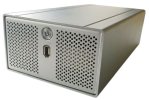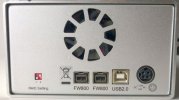I would like to configure the pictured enclosure in RAID 1. (N.B. : I would not have buyed it years ago if it was not supporting RAID 1.)
Unfortunately I don't know the model of the enclosure, and it is not written on it. Likely it was written on some missing housing base.
Doing a reverse image search, I could find pictures from quite similar enclosures, but all had a different layout of sockets, so that I could not find the model and the manual.
I tried all four possible combinations of cursors "1" and "2".
With two 1TB hard disks, I was hoping to see a unique 1TB (mirrored) storage for the RAID 1, but I see either:
Maybe it is the configuration same for this unbranded enclosure. (I think it was a LaCie.)
I remember from an Icy Box RAID, that there was some procedure so set the enclosure in RAID 1, but unfortunately, I cannot remember it.
(Maybe moving some cursor with the power button being hold down ?)
I assume there is a quite similar procedure to set this enclosure in RAID 1 ...
Can you remember the procedure for a quite similar model to set it in RAID 1 ?
If yes, I would attempt it, write some test file, and check that it was written on each of the two hard drives.
Thanks.
Unfortunately I don't know the model of the enclosure, and it is not written on it. Likely it was written on some missing housing base.
Doing a reverse image search, I could find pictures from quite similar enclosures, but all had a different layout of sockets, so that I could not find the model and the manual.
I tried all four possible combinations of cursors "1" and "2".
With two 1TB hard disks, I was hoping to see a unique 1TB (mirrored) storage for the RAID 1, but I see either:
- one 2TB storage (likely JBOD and RAID 0)
- two independant 1TB storages
Maybe it is the configuration same for this unbranded enclosure. (I think it was a LaCie.)
I remember from an Icy Box RAID, that there was some procedure so set the enclosure in RAID 1, but unfortunately, I cannot remember it.
(Maybe moving some cursor with the power button being hold down ?)
I assume there is a quite similar procedure to set this enclosure in RAID 1 ...
Can you remember the procedure for a quite similar model to set it in RAID 1 ?
If yes, I would attempt it, write some test file, and check that it was written on each of the two hard drives.
Thanks.


